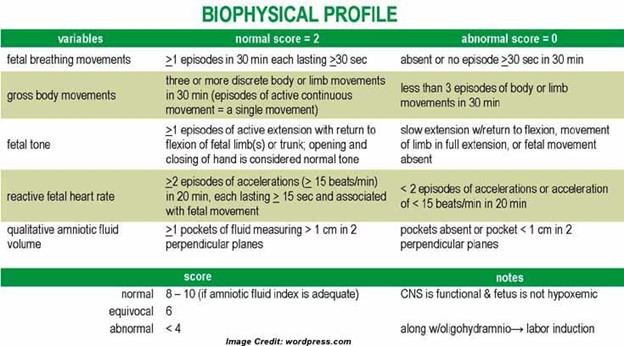Advantages and limitations of NST
Advantages and limitations of NST ( 5 Questions)
A nurse is caring for a pregnant client who has a nonreactive or nonreassuring result on a nonstress test (NST).
The healthcare provider orders a biophysical profile (BPP) to further assess fetal well-being.
What components are included in a BPP? (Select all that apply.)
A biophysical profile (BPP) is a prenatal test that evaluates the well-being of the fetus by combining an ultrasound examination with a nonstress test. The test assesses five components: fetal heart rate, breathing, movement, tone, and amniotic fluid volume. Each component is scored as 2 (normal) or 0 (abnormal), and a total score of 8 or 10 is normal, 6 is equivocal, and 4 or less is abnormal.
A biophysical profile (BPP) is a prenatal test that evaluates the well-being of the fetus by combining an ultrasound examination with a nonstress test. The test assesses five components: fetal heart rate, breathing, movement, tone, and amniotic fluid volume. Each component is scored as 2 (normal) or 0 (abnormal), and a total score of 8 or 10 is normal, 6 is equivocal, and 4 or less is abnormal.
Fetal heart rate is not part of the ultrasound assessment, but rather the nonstress test. The nonstress test evaluates fetal heart rate and response to fetal movement.
A biophysical profile (BPP) is a prenatal test that evaluates the well-being of the fetus by combining an ultrasound examination with a nonstress test. The test assesses five components: fetal heart rate, breathing, movement, tone, and amniotic fluid volume. Each component is scored as 2 (normal) or 0 (abnormal), and a total score of 8 or 10 is normal, 6 is equivocal, and 4 or less is abnormal.
A biophysical profile (BPP) is a prenatal test that evaluates the well-being of the fetus by combining an ultrasound examination with a nonstress test. The test assesses five components: fetal heart rate, breathing, movement, tone, and amniotic fluid volume. Each component is scored as 2 (normal) or 0 (abnormal), and a total score of 8 or 10 is normal, 6 is equivocal, and 4 or less is abnormal.
A biophysical profile (BPP) is a prenatal test that evaluates the well-being of the fetus by combining an ultrasound examination with a nonstress test. The test assesses five components: fetal heart rate, breathing, movement, tone, and amniotic fluid volume. Each component is scored as 2 (normal) or 0 (abnormal), and a total score of 8 or 10 is normal, 6 is equivocal, and 4 or less is abnormal.
Choice C is wrong because fetal heart rate is not part of the ultrasound assessment, but rather the nonstress test. The nonstress test evaluates fetal heart rate and response to fetal movement.
Normal ranges for each component are as follows:
• Fetal heart rate: At least two accelerations in 20 minutes
• Fetal breathing: At least one episode of > 30s or >20s in 30 minutes
• Fetal movement: At least three discrete body/limb movement in 30 minutes
• Fetal tone: At least one episode of active extension with return to flexion of fetal limb(s) or trunk, opening and closing of hand considered to be normal tone
• Amniotic fluid volume: At least one vertical pocket > 2 cm in the vertical axis or AFI of 5 cm

